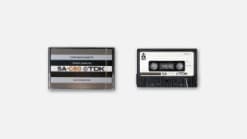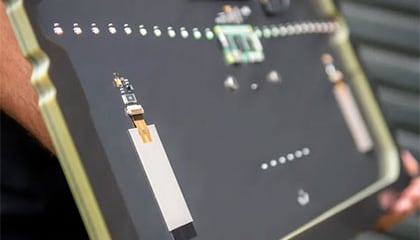Taking a modern approach to 80s Hip-Hop by TDK's PiezoListen™
We have dedicated ourselves to the guiding principle: Contribute to culture and industry through creativity. Our more recent boombox project with hacker royalty Joe Grand, also known as Kingpin, embodies the three core values of our motto – culture, industry, and creativity. Blending the hip-hop culture with break-dancers, cutting-edge manufacturing techniques with super thin speakers, and a nod to TDK’s past are all included. We are delighted to claim that inspiration for the entire project was inspired by those speakers – our PiezoListen™ speakers.
King of hackers

Joe Grand, aka Kingpin - A prototype of the boombox lies on his desk in front of him.
(credit: Jon Jensen Photography)
Engineer Joe Grand is a well-known cybersecurity expert and one of the most skilled hardware hackers in the world, known in the community as Kingpin. In 1998, as a member of L0pht Heavy Industries, one of the original cybersecurity think tanks, he, alongside six other members, testified before the US Senate on the state of government computer security. In 2020, Grand’s name hit the headlines again by successfully hacking into a Trezor wallet to recover $2 million worth of cryptocurrency for its owner, who had forgotten the PIN. But, most of the time, Grand likes taking on engineering projects – well, because it is fun. One of his craziest projects was the ‘Pizza Compass’ – a handy gadget for finding the nearest pizza parlor.
The birth of an idea
We initially got in touch with Grand with the hope that he could create a new project based on our parts. After combing through our product portfolio, he found our PiezoListen™ speakers, which are widely used in the automotive industry, and it all came together. He leaped at the chance. Being an avid lover of hip-hop music and growing up listening to it play from TDK-branded cassette tapes, he came up with a concept that would interest not only the engineering community but also the general public.
“Growing up in the 80s, I remember clearly the sounds that were coming out of New York,” said Grand. “I had a friend with a boombox, and we’d listen to hip-hop innovators like The Fat Boys and Grandmaster Flash while walking around the neighborhood. People must have thought we were crazy; I thought we were the coolest thing ever.”
His project was to recreate his childhood memory by building a boombox – one that has several high-tech twists and is evocative of those gigantic monsters from the 80s. As it would be a one-off, the design of the front panel would pay homage to street art culture – making it an original masterpiece.
Boomboxes were closely related to TDK because we were one of the major cassette tape vendors during the 70s and 80s when cassette players were at their peak. That would be the seed for one of Grand’s more original design concepts, but we’ll come to that later.

In the 80s, when boomboxes gained
widespread popularity, TDK-branded cassette
tapes were a common sight.
Grand pictured a boombox similar to some of the vintage 80s boomboxes in height and width. But because of how thick the PiezoListen™ speaker is – imagine the thickness of a standard ID card – it would also be the thinnest boombox ever.
The piezoelectric effect - utilizing voltage to control the deformation of a piezoelectric material - causes piezoelectric speakers to produce sound. TDK’s PiezoListen™ can make almost any hard surface, such as glass, plastic or ceramic, into a speaker by vibrating.
“That got me thinking,” said Grand. “Could the boombox’s green printed circuit board (PCB) be the actual speaker? To test out my theory, I attached PiezoListen™ to a piece of PCB material, and it worked – it was pretty loud too.”
Cutting-edge manufacturing
If he wanted to create the world’s thinnest boombox, the PCB would need to contain all the electronics, including the speakers. The board would, therefore, be completely exposed. Grand’s vision was for the front of the boombox to be aesthetically appealing and for the back to be clean and simple. He made the decision to cover up all of the traces on the PCB's inner layers so that nobody could see them. This would need the usage of via-in-pad, in which the interlayer connections of the PCB are constructed directly into the landing pads of the component. This is commonplace in modern consumer electronics, but it was unclear whether it could be stretched to the large boombox dimensions.
Many of the vintage boomboxes included LEDs. Although most were purely for decoration, some lights were functional, indicating volume levels, for example. Grand wanted the PCB in his boombox to actually light up. Instead of drilling through-holes in the PCB for the LEDs, he asked the manufacturer whether they could mill holes only partly through the PCB. In this manner, when the LEDs were inserted from the back, the light would diffuse on the front through the PCB material. When the manufacturer confirmed that they could do controlled-depth milling, incorporating capacitive touch buttons for operating the boombox (play, pause, volume, etc.) would also be possible.
To protect the components and battery, which is the thickest element of the system, Grand added a simple frame bringing the total thickness of the boombox to less than a finger width.
The final touch
Grand never intended to include a real cassette player, but if the boombox was going to be true to its heritage, then a cassette tape was a necessity. And, if he was going to use a cassette tape, it had to have a function.
The final design of Grand's boombox requires a cassette tape to operate - although he also included a normal on/off button as an emergency fail-safe. The system will not switch on until the magnets are paired by inserting the cassette tape into the slot, which, incidentally, was yet another milling issue.

A TDK cassette tape is used to switch on the boombox.
(credit: Jon Jensen Photography)
Joe Grand’s TDK boombox
And here is the final product - the World’s thinnest boombox.
Watch Joe Grand’s journey in creating the world’s thinnest boombox.
The ability to incorporate art, music and engineering was, in Grand’s opinion, the most interesting aspect of the project. He said: “It was a lot to take on, but that is what intrigued me about it, and I believe that’s what will also excite other people.”
About PiezoListen™ speakers

Grand’s boombox uses two PiezoListen speakers attached
directly to the PCB, in effect, turning it into a speaker.
(credit: Jon Jensen Photography)
The piezoelectric effect can be used to produce sound by cycling the current in a way that causes the material to vibrate at the desired frequencies. Applications for piezoelectric speakers are numerous. Even so, they are becoming more and more common in car audio systems, where their small size and light weight are just as crucial as their acoustic performance.
